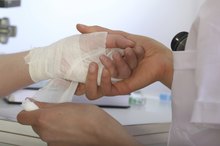What Are the Treatments for Ice Pack Burn?
Burns to the skin are usually associated with heat, but severe cold can damage your skin in a similar way. If you have ever used an ice pack to treat muscle strains or sprains, avoid direct exposure of the ice pack on your skin. The freezing temperatures of a cold pack directly on your skin can produce localized areas of tissue damage called ice pack burn, or frostbite. Prevent ice pack burns by placing a towel or cloth between your skin and the ice pack.
Warming the Skin
Warming the area that has come in direct contact with the ice pack is essential to stopping the frostbite, or burn, from becoming severe enough to damage your blood vessels. You might realize you have an ice pack burn if you develop blisters, if your skin is yellowish-gray in color, or if it feels numb, itchy or painful with a burning sensation. The Mayo Clinic explains that re-establishing a normal body temperature must be a gradual process to avoid burning yourself and causing more damage. Soaking the affected limb in warm water, using warm compresses or wrapping yourself in blankets can gradually restore feeling to your ice pack burn. If you choose a warm soak, the National Institutes of Health suggest water temperatures of at least 104 degrees F, but no hotter than 108 degrees. A 20-minute soak should see improvement; your ice pack burn will start to tingle and become red in color as your skin thaws.
- Warming the area that has come in direct contact with the ice pack is essential to stopping the frostbite, or burn, from becoming severe enough to damage your blood vessels.
- A 20-minute soak should see improvement; your ice pack burn will start to tingle and become red in color as your skin thaws.
Treating Blisters
How to Soothe Burns
Learn More
Blistering is a sign of an ice pack burn, just as with heat burns. Treating the blisters appropriately will help avoid infection and further complications. According to a May 1999 issue of the British Journal of Sports Medicine, de-roofing the blister—removing excess tissue—allows doctors to more effectively dress the wound 1. You may develop an open wound as a result of incorrect usage of an ice pack; treat the wound as you would any other, with antibiotic ointments, a barrier substance such as petroleum jelly, and gauze bandages to keep the area moist and free of infection. If the blistered area is large, you might need to change the dressings and re-apply first aid to the area for up to 10 days.
- Blistering is a sign of an ice pack burn, just as with heat burns.
- You may develop an open wound as a result of incorrect usage of an ice pack; treat the wound as you would any other, with antibiotic ointments, a barrier substance such as petroleum jelly, and gauze bandages to keep the area moist and free of infection.
Professional Medical Attention
An ice pack burn or frostbitten area that does not begin to tingle, burn or regain a pinkish hue may be the sign of more extensive damage of the blood vessels and muscles underneath the skin, according to the National Institutes of Health. If the burned area stays numb with skin that feels hard and cold, you may need professional medical attention. Contact your family doctor to determine what course of action to take to avoid complications such as nerve damage and gangrene.
Related Articles
References
- British Journal of Sports Medicine: Frostbite at the Gym: A Case Report of an Ice Pack Burn; May 1999
- Mayo Clinic: Frostbite First Aid
- Medline Plus: Frostbite
- Millet JD, Brown RK, Levi B, et al. Frostbite: Spectrum of imaging findings and guidelines for management. Radiographics. 2016;36(7):2154-2169. doi:10.1148/rg.2016160045
- American Academy of Pediatrics. Care of the young athlete patient education handouts: Use of ice and heat. 2010.
- Laskowski-jones L, Jones LJ. Frostbite: Don't be left out in the cold. Nursing. 2018;48(2):26-33. doi:10.1097/01.NURSE.0000529802.75665.d7
Writer Bio
Erica Roth has been a writer since 2007. She is a member of the Society of Professional Journalists and was a college reference librarian for eight years. Roth earned a Bachelor of Arts in French literature from Brandeis University and Master of Library Science from Simmons College Graduate School of Library and Information Science. Her articles appear on various websites.








